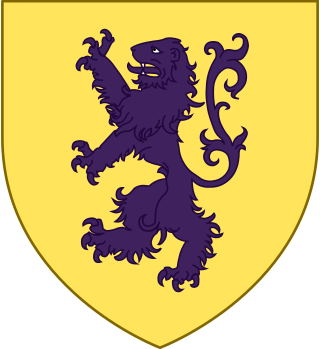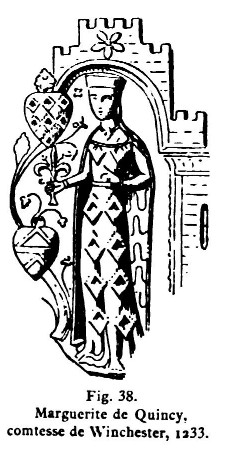
The Earldom of Chester was one of the most powerful earldoms in medieval England, extending principally over the counties of Cheshire and Flintshire. Since 1301 the title has generally been granted to heirs apparent to the English throne, and after 1707 the British throne. From the late 14th century, it has been given only in conjunction with that of Prince of Wales.

Earl of Lincoln is a title that has been created eight times in the Peerage of England, most recently in 1572. The title was borne by the Dukes of Newcastle-under-Lyne from 1768 to 1988, until the dukedom became extinct.

Saer de Quincy, 1st Earl of Winchester was one of the leaders of the baronial rebellion against John, King of England, and a major figure in both the kingdoms of Scotland and England in the decades around the turn of the twelfth and thirteenth centuries.

William III de Ferrers, 5th Earl of Derby of Chartley Castle in Staffordshire, was an English nobleman and major landowner, unable through illness to take much part in national affairs. From his two marriages, he left numerous children who married into noble and royal families of England, France, Scotland and Wales.

Ranulf de Blondeville, 6th Earl of Chester and 1st Earl of Lincoln, known in some references as the 4th Earl of Chester, was one of the "old school" of Anglo-Norman barons whose loyalty to the Angevin dynasty was consistent but contingent on the receipt of lucrative favours. He has been described as "almost the last relic of the great feudal aristocracy of the Conquest".

Alan, 1st Earl of Richmond, Breton Alan Penteur, also known as "Alan the Black", was a Breton noble who fought for Stephen, King of England. Alan was the third son of Stephen, Count of Tréguier, and Hawise de Guingamp.

Henry de Lacy, Earl of Lincoln, Baron of Pontefract, Lord of Bowland, Baron of Halton and hereditary Constable of Chester, was an English nobleman and confidant of King Edward I. He served Edward in Wales, France, and Scotland, both as a soldier and a diplomat. Through his mother he was a great-grandson of Amadeus IV, Count of Savoy. He is the addressee, or joint composer, of a poem by Walter of Bibbesworth about crusading, La pleinte par entre missire Henry de Lacy et sire Wauter de Bybelesworthe pur la croiserie en la terre seinte.
Matilda of Chester, Countess of Huntingdon was an Anglo-Norman noblewoman, sometimes known as Maud and sometimes known with the surname de Kevelioc. She was a daughter of Hugh de Kevelioc, 5th Earl of Chester, and the wife of David of Scotland, Earl of Huntingdon.
Maud de Lacy was an English noblewoman, being the eldest child of John de Lacy, 2nd Earl of Lincoln, and the wife of Richard de Clare, 5th Earl of Hertford, 6th Earl of Gloucester.
Maud of Gloucester, Countess of Chester, also known as Matilda, was an Anglo-Norman noblewoman and the daughter of Robert, 1st Earl of Gloucester, an illegitimate son of King Henry I of England, and Mabel, daughter and heiress of Robert Fitzhamon. Her husband was Ranulf de Gernon, 4th Earl of Chester.
Maud Marshal, Countess of Norfolk, Countess of Surrey was an Anglo-Norman noblewoman and a wealthy co-heiress of her father William Marshal, 1st Earl of Pembroke, and her mother Isabel de Clare suo jure 4th Countess of Pembroke. Maud was their eldest daughter. She had two husbands: Hugh Bigod, 3rd Earl of Norfolk, and William de Warenne, 5th Earl of Surrey.

Margaret de Quincy, suo jure 2nd Countess of Lincoln was a wealthy English noblewoman and heiress having inherited in her own right the Earldom of Lincoln and honours of Bolingbroke from her mother Hawise of Chester, received a dower from the estates of her first husband, and acquired a dower third from the extensive earldom of Pembroke following the death of her second husband, Walter Marshal, 5th Earl of Pembroke. Her first husband was John de Lacy, 2nd Earl of Lincoln, by whom she had two children. He was created 2nd Earl of Lincoln by right of his marriage to Margaret. Margaret has been described as "one of the two towering female figures of the mid-13th century".
Edmund de Lacy, Earl of Lincoln (c.1230–1258) was an important landholder in Northern England, with a strategic manor at Stanbury which was important for east–west communication, and as Lord of the Honour of Pontefract he possessed Pontefract Castle.

John de Lacy, 2nd Earl of Lincoln was hereditary Constable of Chester, 7th Baron of Pontefract, 8th Baron of Halton and 8th Lord of Bowland.

John fitz Richard was an Anglo-Norman soldier, Baron of Halton and hereditary Constable of Chester. Historical records refer to him as "John, Constable of Chester". He died at Acre in the Holy Land.

The Constable of Chester was a mediaeval hereditary office held by the Barons of Halton. The functions of the Constable are unclear, possibly they related to the custody of Chester Castle, as was the main function of most mediaeval constables, but Sanders (1960) says the office-holder was constable for the entire County Palatine.









